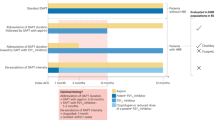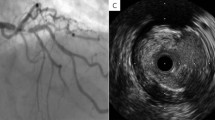Abstract
In Europe, the use of interventional cardiology, including percutaneous coronary intervention (PCI), is increasing rapidly. The use of anticoagulation agents in PCI procedures is essential, but despite technical improvements, a significant associated bleeding risk still exists: more than 5% of patients are estimated to require transfusion, and around a further 13% experience minor bleeding. The methods used to detect and measure blood loss following PCI, however, vary widely between institutions and clinical trials. The risk of bleeding is influenced by therapeutic options and patient-specific characteristics, such as age, anemia and previous exposure to anticoagulants. Bleeding is associated with death, and also with less severe conditions such as thrombocytopenia, anemia, and hematoma, which have major impacts on patients' welfare and length of hospital stay, and on hospital budgets. Unfractionated heparin is the most widely used anticoagulant during PCI. Heparin, antiplatelet agents and other anticoagulants, however, have limitations that make it difficult to achieve a level of anticoagulation that prevents ischemic events without promoting bleeding. The use of low-molecular-weight heparin and the addition of glycoprotein IIb/IIIa inhibitors offer improved outcomes, but safer and more effective therapeutic agents are still required. New anticoagulants, including direct thrombin inhibitors such as bivalirudin, show similar levels of efficacy to heparin plus glycoprotein IIb/IIIa inhibitors, but with fewer hemorrhagic complications, and might advance clinical practice. This review evaluates the impact of PCI-related bleeding on patients' outcomes and hospital resources, examines methods for the detection and measurement of bleeding, and appraises the therapeutic options—particularly the newer agents—available to minimize hemorrhagic complications.
This is a preview of subscription content, access via your institution
Access options
Subscribe to this journal
Receive 12 print issues and online access
$209.00 per year
only $17.42 per issue
Buy this article
- Purchase on Springer Link
- Instant access to full article PDF
Prices may be subject to local taxes which are calculated during checkout

Similar content being viewed by others
References
Weitz JI and Bates SM (2000) Beyond heparin and aspirin: new treatments for unstable angina and non-Q-wave myocardial infarction. Arch Intern Med 160: 749–758
Silber S et al. (2005) Guidelines for percutaneous coronary interventions. Eur Heart J 26: 804–847
Patrono C et al. (2004) Expert consensus document on the use of antiplatelet agents. The task force on the use of antiplatelet agents in patients with atherosclerotic cardiovascular disease of the European society of cardiology. Eur Heart J 25: 166–181
Topol EJ et al. (1993) Use of a direct antithrombin, hirulog, in place of heparin during coronary angioplasty. Circulation 87: 1622–1629
Lopez LM (2003) Clinical challenges of bleeding in percutaneous coronary intervention. Am J Health-Syst Pharm 60 (Suppl 3): S8–S14
Kinnaird TD et al. (2003) Incidence, predictors, and prognostic implications of bleeding and blood transfusion following percutaneous coronary interventions. Am J Cardiol 92: 930–935
Lauer MA et al. (2002) Practice patterns and outcomes of percutaneous coronary interventions in the United States: 1995 to 1997. Am J Cardiol 89: 924–929
Rao AK et al. (1988) Thrombolysis in Myocardial Infarction (TIMI) Trial—phase I: hemorrhagic manifestations and changes in plasma fibrinogen and the fibrinolytic system in patients treated with recombinant tissue plasminogen activator and streptokinase. J Am Coll Cardiol 11: 1–11
Berkowitz SD et al. (1997) Incidence and predictors of bleeding after contemporary thrombolytic therapy for myocardial infarction. The Global Utilization of Streptokinase and Tissue plasminogen activator for Occluded coronary arteries (GUSTO) I Investigators. Circulation 95: 2508–2516
Maroo A and Lincoff AM (2004) Bivalirudin in PCI: an overview of the REPLACE-2 trial. Semin Thromb Hemost 30: 329–336
Berkowitz SD et al. (2001) Prospective comparison of hemorrhagic complications after treatment with enoxaparin versus unfractionated heparin for unstable angina pectoris or non-ST-segment elevation acute myocardial infarction. Am J Cardiol 88: 1230–1234
Goodman SG et al. (2003) Randomized evaluation of the safety and efficacy of enoxaparin versus unfractionated heparin in high-risk patients with non-ST-segment elevation acute coronary syndromes receiving the glycoprotein IIb/IIIa inhibitor eptifibatide. Circulation 107: 238–244
Stone GW et al. (2004) Acute Catheterization and Urgent Intervention Triage strategY (ACUITY) trial: study design and rationale. Am Heart J 148: 764–775
Moscucci M (2002) Frequency and costs of ischemic and bleeding complications after percutaneous coronary interventions: rationale for new antithrombotic agents. J Invasive Cardiol 14 (Suppl B): 55B–64B
Montalescot G et al. (2005) Description of modern practices of percutaneous coronary intervention and identification of risk factors for adverse outcome in the French nationwide OPEN registry. Heart 91: 89–90
Lincoff AM et al. (2003) Bivalirudin and provisional glycoprotein IIb/IIIa blockade compared with heparin and planned glycoprotein IIb/IIIa blockade during percutaneous coronary intervention: REPLACE-2 randomized trial. JAMA 289: 853–863
Moscucci M et al. (2003) Predictors of major bleeding in acute coronary syndromes: the global registry of acute coronary events (GRACE) Eur Heart J 24: 1815–1823
Nikolsky E et al. (2004) Vascular complications associated with arteriotomy closure devices in patients undergoing percutaneous coronary procedures: a meta-analysis. J Am Coll Cardiol 44: 1200–1209
Koreny M et al. (2004) Arterial puncture closing devices compared with standard manual compression after cardiac catheterization. Systematic review and meta-analysis. JAMA 291: 350–357
Saghir T et al. (2003) Transradial diagnostic and percutaneous coronary intervention. J Coll Physicians Surg Pak 13: 242–247
Louvard Y et al. (2004) Comparison of transradial and transfemoral approaches for coronary angiography and angioplasty in octogenarians (the OCTOPLUS study). Am J Cardiol 94: 1177–1180
Agostoni P et al. (2004) Radial versus femoral approach for percutaneous coronary diagnostic and interventional procedures: systematic overview and meta-analysis of randomized trials. J Am Coll Cardiol 44: 349–356
Kassam S et al. (2004) Radial versus femoral access for rescue percutaneous coronary intervention with adjuvant glycoprotein IIb/IIIa inhibitor use. Can J Cardiol 20: 1439–1442
Mann T et al. (1998) Stenting in acute coronary syndromes: a comparison of radial versus femoral access sites. J Am Coll Cardiol 32: 572–576
Smith SC Jr et al. (2001) ACC/AHA guidelines for percutaneous coronary intervention (Revision of the 1993 PTCA guidelines): a report of the American College of Cardiology/American Heart Association Task Force on Practice Guidelines (Committee to Revise the 1993 Guidelines for Percutaneous Transluminal Coronary Angioplasty). J Am Coll Cardiol 37: 2239i–2239ixvi
Chew DP et al. (2005) Bivalirudin versus heparin and glycoprotein IIb/IIIa inhibition among patients with renal impairment undergoing percutaneous coronary intervention (a subanalysis of the REPLACE-2 trial). Am J Cardiol 95: 581–585
Rao SV et al. (2004) Relationship of blood transfusion and clinical outcomes in patients with acute coronary syndromes. JAMA 292: 1555–1562
Milkovich G and Gibson G (2003) Economic impact of bleeding complications and the role of antithrombotic therapies in percutaneous coronary intervention. Am J Health Syst Pharm 60 (Suppl 3): S15–S21
Cohen DJ et al. (2004) Economic evaluation of bivalirudin with provisional glycoprotein IIB/IIIA inhibition versus heparin with routine glycoprotein IIB/IIIA inhibition for percutaneous coronary intervention: results from the REPLACE-2 trial. J Am Coll Cardiol 44: 1792–1800
Becker DL et al. (1999) Exosites 1 and 2 are essential for protection of fibrin-bound thrombin from heparin-catalyzed inhibition by antithrombin and heparin cofactor II. J Biol Chem 274: 6226–6233
Bates SM and Weitz JI (2000) The mechanism of action of thrombin inhibitors. J Invasive Cardiol 12 (Suppl F): 27F–32F
Popma JJ et al. (2004) Antithrombotic therapy during percutaneous coronary intervention: the seventh ACCP Conference on Antithrombotic and Thrombolytic Therapy. Chest 126 (Suppl 3): 576S–599S
Popma JJ et al. (2001) Antithrombotic therapy in patients undergoing percutaneous coronary intervention. Chest 119: 321S–336S
Tolleson TR et al. (2003) Relationship between heparin anticoagulation and clinical outcomes in coronary stent intervention. J Am Coll Cardiol 41: 386–393
Chew DP et al. (2001) Defining the optimal activated clotting time during percutaneous coronary intervention. Circulation 103: 361–966
Hirsh J (1991) Heparin. N Engl J Med 324: 1565–1574
Klein W et al. (2003) Patterns of use of heparins in ACS. Correlates and hospital outcomes: the Global Registry of Acute Coronary Events (GRACE). Thromb Haemost 90: 519–527
Ferguson JJ et al. (2004) Enoxaparin vs unfractionated heparin in high-risk patients with non-ST-segment elevation acute coronary syndromes managed with an intended early invasive strategy: primary results of the SYNERGY randomized trial. JAMA 292: 45–54
Borentain M et al. (2005) Low-molecular-weight heparin vs unfractionated heparin in percutaneous coronary intervention: a combined analysis. Catheter Cardiovasc Interv 65: 212–221
Mehta SR et al. (2005) Arixtra® study in percutaneous coronary intervention: a randomised evaluation (ASPIRE) pilot trial. Circulation 111: 1390–1397
Warkentin TE et al. (1995) Heparin-induced thrombocytopenia in patients treated with low-molecular-weight heparin or unfractionated heparin. N Engl J Med 332: 1330–1335
Campbell KR et al. (2000) Bivalirudin in patients with heparin-induced thrombocytopenia undergoing percutaneous coronary intervention. J Invasive Cardiol 12 (Suppl F): 14F–9
Singer RL et al. (1993) Complications from heparin-induced thrombocytopenia in patients undergoing cardiopulmonary bypass. Chest 104: 1436–1440
British Cardiovascular Intervention Society (2003) British Cardiovascular Intervention Society audit [http://www.bcis.org.uk/resources/audit/audit2003] (accessed 10 May 05)
de Queiroz Fernandes Araújo JO et al. (2004) Efficacy and safety of abciximab on acute myocardial infarction treated with percutaneous coronary interventions: a meta-analysis of randomized, controlled trials. Am Heart J 148: 937–943
Brener SJ et al. (1998) Randomized, placebo-controlled trial of platelet glycoprotein IIb/IIIa blockade with primary angioplasty for acute myocardial infarction. ReoPro and Primary PTCA Organization and Randomized Trial (RAPPORT) Investigators. Circulation 98: 734–741
De Luca G et al. (2005) Abciximab as adjunctive therapy to reperfusion in acute ST-segment elevation myocardial infarction: a meta-analysis of randomized trials. JAMA 293: 1759–1765
Boeynaems JM et al. (2005) P2Y receptor antagonists in thrombosis. Curr Opin Investig Drugs 6: 275–282
Herbert JM et al. (2003) P2Y12, a new platelet ADP receptor, target of clopidogrel. Semin Vasc Med 3: 113–122
van Giezen JJ et al. (2005) Preclinical and clinical studies with selective reversible direct P2Y12 antagonists. Semin Thromb Hemost 31: 195–204
Nemergut C and Cheng JWM (2000) Use of direct thrombin inhibitors in acute coronary syndrome. Clin Ther 22: 937–948
European Medicines Agency (2005) [http://www.emea.eu.int/index/indexh1.htm] (accessed 10 May 05)
Hirahara T et al. (2004) Prospective randomized study of argatroban versus heparin anticoagulation therapy after percutaneous coronary intervention for acute myocardial infarction. J Cardiol 44: 47–52
Bittl JA et al. (2001) Bivalirudin versus heparin during coronary angioplasty for unstable or postinfarction angina: final report reanalysis of the Bivalirudin Angioplasty Study. Am Heart J 142: 952–959
Kong DF et al. (1999) Clinical outcomes of bivalirudin for ischemic heart disease. Circulation 100: 2049–2053
Lincoff AM et al. (2004) Long-term efficacy of bivalirudin and provisional glycoprotein IIb/IIIa blockade vs heparin and planned glycoprotein IIb/IIIa blockade during percutaneous coronary revascularization: REPLACE-2 randomized trial. JAMA 292: 696–703
Randomized Trial to Evaluate the Relative PROTECTion against Post-PCI Microvascular Dysfunction and Post-PCI Ischemia among Anti-Platelet and Anti-Thrombotic Agents. [http://www.timi.org/home.htm] (accessed 22 July 2005)
Collet JP et al. (2005) Non-ST-segment elevation acute coronary syndrome in patients with renal dysfunction: benefit of low-molecular-weight heparin alone or with glycoprotein IIb/IIIa inhibitors on outcomes. The Global Registry of Acute Coronary Events Eur Heart J [doi:10.1093/eurheartj/ehi337]
Hulot JS et al. (2005) Dosing strategy in patients with renal failure receiving enoxaparin for the treatment of non-ST-segment elevation acute coronary syndrome. Clin Pharmacol Ther 77: 542–552
Berger PB et al. 2005. The relation of renal function to ischemic and bleeding outcomes with 2 different glycoprotein IIb/IIIa inhibitors: the do Tirofiban and ReoPro Give Similar Efficacy Outcome (TARGET) trial. Am Heart J 149: 869–75
Chew DP et al. (2003) Bivalirudin provides increasing benefit with decreasing renal function: a meta-analysis of randomized trials. Am J Cardiol 92: 919–923
Author information
Authors and Affiliations
Corresponding author
Ethics declarations
Competing interests
The author declares no competing financial interests.
Rights and permissions
About this article
Cite this article
Rothman, M. Drug Insight: bleeding after percutaneous coronary intervention-risks, measures and impact of anticoagulant treatment options. Nat Rev Cardiol 2, 465–474 (2005). https://doi.org/10.1038/ncpcardio0311
Received:
Accepted:
Issue Date:
DOI: https://doi.org/10.1038/ncpcardio0311
This article is cited by
-
Tirofiban Combined with Fondaparinux for Post-PCI Treatment of Patients with Acute Coronary Syndrome and Mild Renal Insufficiency
Cell Biochemistry and Biophysics (2015)
-
Vascular access site complications after PCI: current status and future directions
Nature Clinical Practice Cardiovascular Medicine (2006)
-
Drug Insight: antithrombotic therapy after percutaneous coronary intervention in patients with an indication for anticoagulation
Nature Clinical Practice Cardiovascular Medicine (2006)



